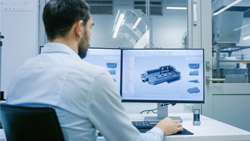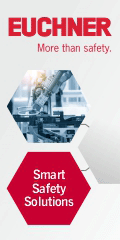
Posted to News on 6th Oct 2018, 11:21
Time for machine builders to innovate with material selection
Machine builders are continually innovating but one area that is ripe for innovation is material selection. This article explores some of the opportunities available.

Innovation is an essential part of machine building, particularly in the UK where engineering time is costly and there is tough competition from lower-cost regions. Not only can innovation keep costs down but, most importantly, it provides technical advantages: for example, machines can operate faster, produce higher-quality output, require less maintenance, offer better remote diagnostics and less downtime.
Over the last 20 years machine builders have innovated with control systems, fieldbus communications, machinery safety, electromechanical actuation in place of pneumatics, electronically synchronised axes instead of cams, graphical and touchscreen interfaces, modular aluminium frameworks replacing fabricated steel, energy-efficient motors and drives, vision systems and robotics - not to mention the CAD/CAM/CAE tools that have streamlined design and manufacture.
Material choices
The list above mentions the use of aluminium frameworks, which have now largely replaced fabricated steel for all but heavy-duty machines. Versatile and easy to work with, aluminium profiles and the myriad of fasteners and accessories offer advantages that outweigh the apparent disadvantage of a higher purchase cost for the raw material. Are there other areas where innovative material choices could be advantageous?
Traditionally the materials of choice for machine builders have been predominantly steel and aluminium. Some components are machined from polymers or composites such as Tufnol, but these tend to be in the minority. More recently additive manufacturing technologies - often referred to as 3D printing - have grown in popularity for components including nests, gripper fingers and even relatively mundane items such as sensor brackets. Depending on the application, these will be manufactured from polymers, metals or composites.
If a clean-sheet-of-paper approach is taken to the design of a component or, better still, a sub-assembly of components, the opportunity presents itself for true innovation. Functions from multiple components can be combined to produce a lighter, lower-cost single part. When taking a fresh look, the designer can take a step back and consider materials other than the conventional options of steel and aluminium.
Characteristics

If the machine builder owns an additive manufacturing system then there will probably be a limited range of materials that can be used with that system, so that may influence material choice. On the other hand, if additive manufacturing bureaux are used, then the machine builder can select from the wider range of materials available and then seek a bureau with a machine capable of processing the chosen material.
How to innovate in material selection?
Preparing a list of candidate materials might sound easy but a designer is likely to draw up a list based on experience and existing knowledge; the resultant list is therefore unlikely to be truly innovative. A more thorough exercise can be undertaken by searching materials databases and identifying "any' material classes that fulfil certain criteria. Materials databases have, themselves, been available for 20 years or more, but these have tended to require relatively costly subscriptions that put them beyond the reach of most machine builders. In addition, some databases are not suitable for comparing different classes of materials, and the databases do not always have up-to-date links to suppliers of the selected materials.
Materials comparison website Matmatch was founded to provide easily accessible, diverse and detailed material information online. Matmatch is ambitiously working towards developing a modern material selection knowledge hub, combining quantitative material data with qualitative information such as applications and processing methods.
To construct this resource Matmatch combines information from traditional materials sources, some modern digital sources and materials manufacturers. The aim is to link general material properties, manufacturing information, standards, use cases, available suppliers and more to provide the most comprehensive set of materials information.
This unified database linking specific information about materials is empowering machine design engineers to make the innovative material selections. This approach may still result in some components being specified in steel or aluminium but it may also deliver significant benefits. For instance, by specifying alternative materials dynamic machinery could be made lighter, resulting in higher accelerations, shorter cycle times and reduced wear on bearings - or, if cycle times are not critical, smaller motors and drives could be specified to save costs and improve energy efficiency.
Of course, material selection cannot be considered in isolation; specifying a different material might mean that more attention has to be paid to the design to ensure component stiffness or strength are not compromised, and there might be implications for manufacturing technologies as well. But the key message is that innovative materials selection has the potential to offer machine builders cost savings and technological advantages over their competitors, as well as benefits for end users.
Follow the link for more information about the Matmatch materials comparison website.
Want the latest machine building news straight to your inbox? Become a MachineBuilding member for free today >>















